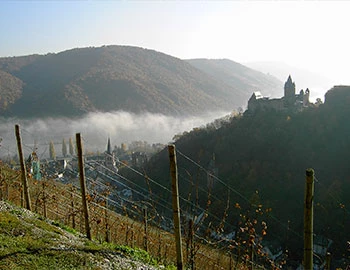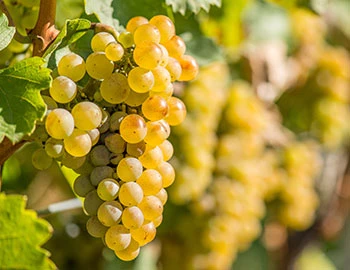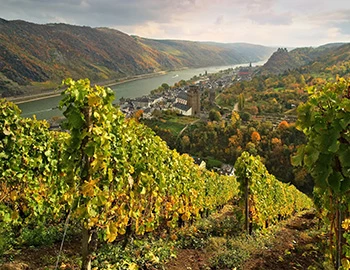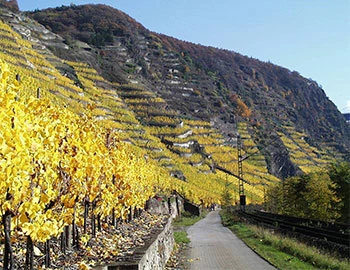Bacharacher Wolfshöhle Spätlese 2015
QmP Mittelrhein, Ratzenberger, 750 ml

| Grape variety: | Riesling |
| Producer: | Weingut Ratzenberger / Fam. Ratzenberger |
| Origin: | Germany / Mittelrhein |
Description
A lively, lusciously sweet Riesling with a bouquet of various citrus fruits. It shows a wonderfully broad spectrum of aromas with hints of blackcurrant, honey and herbs. On the palate it is opulent and creamy, but also very juicy. It is rounded off by a well integrated, animating acidity. The finish is long and fruity.
Best wine trader for matured wines 2024

Baur au Lac Vins was honoured by Falstaff as the best wine merchant for mature wines. Thank you very much for the award!
Attributes
| Origin: | Germany / Mittelrhein |
| Grape variety: | Riesling |
| Label: | Vegan |
| Ripening potential: | 5 to 20 years |
| Drinking temperature: | 10 to 12 °C |
| Food Pairing: | Italian antipasti, Apéro pastries, Vegetable dip, Fish ragout with saffron sauce, Cakes, biscuits, pastries |
| Vinification: | fermentation in wooden barrel, fermentation in steel tank |
| Harvest: | hand-picking |
| Maturation: | in steel tank, in large wooden barrel/foudre, on the yeast |
| Bottling: | filtration |
| Volume: | 8.5 % |
| Note: | Contains sulphites |
Weingut Ratzenberger / Fam. Ratzenberger
The most beautiful way of traveling to Bacharach on the Rhine is by boat, passing the famous Loreley cliff. To the left and right of the Middle Rhine, medieval castles and picturesque villages follow in quick succession. Bacharach is one of the most beautiful towns in the Upper Middle Rhine Valley, designated a UNESCO World Heritage Site. Once there, the locality of Steeg can be reached on foot within half an hour or by car in just five minutes.
Steeg is located within a narrow valley of the same name, situated at a 90-degree angle to the Rhine. The steep vineyards, covered mostly with Riesling, with names such as St. Jost, Posten, Kloster Fürstental or Wolfshöhle, benefit from perfect southern exposure. The dangerous and strenuous nature of winemaking is clearly illustrated here, with a slope angle of up to 70%! On reaching the top, after a short break you can savour the view over the mighty river and all the way over to Burg Stahleck.
Various types of slate form the ground on which the Riesling wines evolve with different characters, from fresh “feinherb” wines, Spätlese (late harvest) bottlings with subtle sweetness, to complex Grosses Gewächs, which reveal their full potential with advancing age. In Jochen Ratzenberger’s dark rock cellar, slumbering bottles of old vintages impressively prove this point. And there's a wonderful Riesling sparkling wine which is produced using traditional methods and is riddled by hand – a true discovery for novices and connoisseurs alike. Last but not least are the sumptuous Eisweine (ice wines), precious nectars which nature only provides once every few years in tiny quantities.
For three generations, everyone in the family has contributed to the estate, especially during harvest time. The Ratzenbergers also have two charming holiday apartments, far away from mass tourism, that can be rented for wonderful hiking holidays. www.weingut-ratzenberger.de

Riesling
The cold-weather king
The Riesling is the flagship of the German wine industry. It grows from north to south in all growing areas. It is also comfortable in the neighbouring Alsace region and in Austria. Its specialty is being vinified to a variety of degrees of sweetness, from bone-dry wines to ice wine. Moreover, thanks to its spirited acidity, it ages better than many reds. The typical Riesling smells of citrus, peach and apricot, shows hints of flint, and with maturity develops an idiosyncratic petrol note. It reflects its terroir like hardly any other white variety. Thus, it often gets fuller and more aromatic in Austria than in Germany. In Alsace, in turn, it has a particular mineral taste. Riesling is a wonderful culinary companion. It fits well not only with fish and shellfish, but also takes the heaviness from hearty meals. And with a fine sweetness and acidity balance, it works wonders for Asian cuisine.

Mittelrhein
Mittelrhein: small but fine
With a vineyard area of around 450 hectares, the Mittelrhein (or Middle Rhine) growing region is one of Germany’s smallest. It is bordered to the south by the Rheingau, following the Rhine’s course northward to Königswinter near Bonn, which is the northernmost winegrowing village on the Rhine. In the steep sites along the river, which are still cultivated delicately by hand, the leading variety, Riesling, develops across its entire spectrum, from dry to noble sweet.

Germany
Germany – Into the elite the hard way
Sitting in the heart of Europe, the hilly, lake-dotted landscape of Germany provides ideal, fertile soil for the most diverse vine varieties. From Albalonga to Zweigelt, over 140 different grape varieties are grown on about 100,000 acres, cared for by nearly 50,000 vintners. Most of these vintners are young, modern, internationally trained, inquisitive and urbane. It is hardly surprising, then, that German wine has a good reputation well beyond the country's borders.



